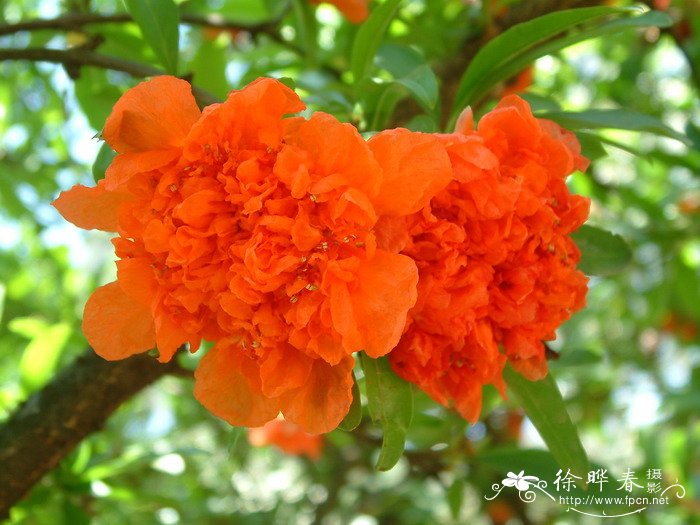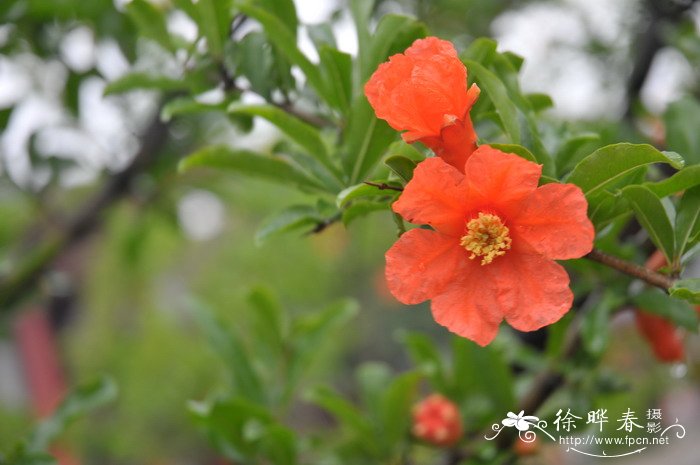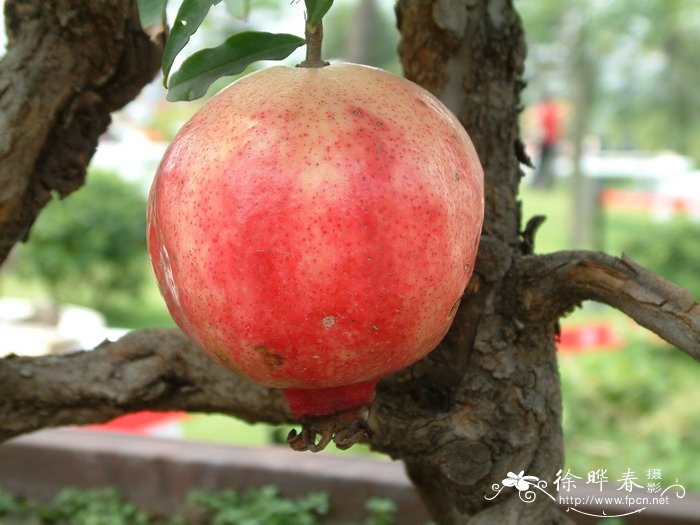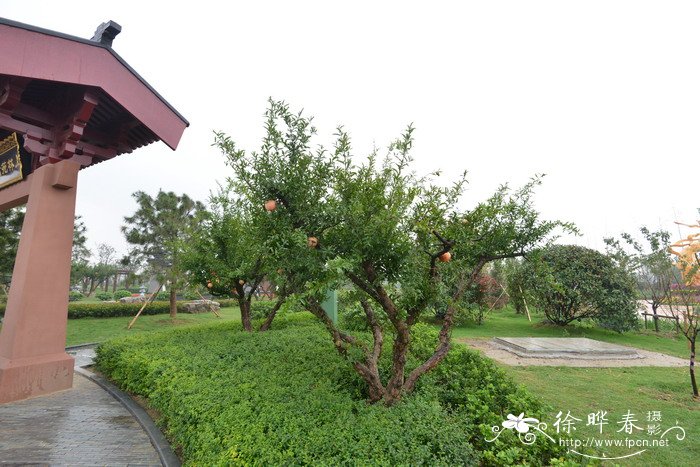石榴Punica granatum
中文名(Chinese Name):石榴
学名(Scientific Name):Punica granatum Linn.
英文名(English Common Name):pomegranate
别名(Chinese Common Name):丹若、若榴木
异名(Synonym):Punica florida Salisb. Punica grandiflora hort. ex Steud. Punica nana L. Punica spinosa Lam.
科属(Family & Genus):石榴科(Punicaceae)石榴属
形态特征(Description):落叶灌木或乔木,高通常3-5米,稀达IO米,枝顶常成尖锐长刺,幼枝具棱角,无毛,老枝近圆柱形。叶通常对生,纸质,矩圆状披针形,长2-9厘米,顶端短尖、钝尖或微凹,基部短尖至稍钝形,上面光亮,侧脉稍细密;叶柄短。花大,1-5朵生枝顶;萼筒长2-3厘米,通常红色或淡黄色,裂片略外展,卵状三角形,长8-13毫米,外面近顶端有1黄绿色腺体,边缘有小乳突;花瓣通常大,红色、黄色或白色,长1.5-3厘米,宽1-2厘米,顶端圆形;花丝无毛,长达13毫米;花柱长超过雄蕊。浆果近球形,直径5-12厘米,通常为淡黄褐色或淡黄绿色,有时白色,稀暗紫色。种子多数,钝角形,红色至乳白色,肉质的外种皮供食用。
分布(Distribution):原产巴尔干半岛至伊朗及其邻近地区,全世界的温带和热带都有种植。
用途(Use):石榴是一种常见果树,我国南北都有栽培。
引自中国植物志英文版:FOC Vol. 13 Page 283
Punica granatum Linnaeus, Sp. Pl. 1: 472. 1753.
石榴 shi liu| Lythraceae | Punica
Shrubs or small trees, 2-3 m tall, glabrous. Branches and branchlets 4-angled, becoming terete with age, often terminating as indurate spines. Petiole 2-10 mm; leaf blade adaxially shiny, lanceolate, elliptic-oblanceolate, or oblong, 2-9 × 1-2 cm, base attenuate, apex obtuse or mucronate. Floral tube red-orange or pale yellow, campanulate-urceolate, 2-3 × 1-1.5 cm; sepals 5-9, erect, deltate. Petals 5-9, bright red-orange [or white], obovate, 1.5-3 × 1-2 cm, apex rounded or obtuse. Stamens numerous, included to exserted. Ovary 8-13-loculed, in 2 or 3 superposed layers, lower locules with axile placentation, upper ones with apparent parietal placentation. Fruit globose, leathery berries, variable in color, red to yellow-green or red-brown, 5-12 cm in diam., crowned by persistent sepals, irregularly dehiscent. Seeds obpyramidal within juicy sarcotestal layer, ruby-red, pink, or yellowish white. Fl. Mar-Jul. 2n = 16, 18.
Widely cultivated in China, and naturalized in W China [widespread in cultivation].
Punica granatum is grown for its showy flowers and edible fruit (pomegranate). It was probably introduced to China from C Asia or Europe during the Han dynasty (207 BCE to 220 CE).





(责任编辑:徐晔春)
学名(Scientific Name):Punica granatum Linn.
英文名(English Common Name):pomegranate
别名(Chinese Common Name):丹若、若榴木
异名(Synonym):Punica florida Salisb. Punica grandiflora hort. ex Steud. Punica nana L. Punica spinosa Lam.
科属(Family & Genus):石榴科(Punicaceae)石榴属
形态特征(Description):落叶灌木或乔木,高通常3-5米,稀达IO米,枝顶常成尖锐长刺,幼枝具棱角,无毛,老枝近圆柱形。叶通常对生,纸质,矩圆状披针形,长2-9厘米,顶端短尖、钝尖或微凹,基部短尖至稍钝形,上面光亮,侧脉稍细密;叶柄短。花大,1-5朵生枝顶;萼筒长2-3厘米,通常红色或淡黄色,裂片略外展,卵状三角形,长8-13毫米,外面近顶端有1黄绿色腺体,边缘有小乳突;花瓣通常大,红色、黄色或白色,长1.5-3厘米,宽1-2厘米,顶端圆形;花丝无毛,长达13毫米;花柱长超过雄蕊。浆果近球形,直径5-12厘米,通常为淡黄褐色或淡黄绿色,有时白色,稀暗紫色。种子多数,钝角形,红色至乳白色,肉质的外种皮供食用。
分布(Distribution):原产巴尔干半岛至伊朗及其邻近地区,全世界的温带和热带都有种植。
用途(Use):石榴是一种常见果树,我国南北都有栽培。
引自中国植物志英文版:FOC Vol. 13 Page 283
Punica granatum Linnaeus, Sp. Pl. 1: 472. 1753.
石榴 shi liu| Lythraceae | Punica
Shrubs or small trees, 2-3 m tall, glabrous. Branches and branchlets 4-angled, becoming terete with age, often terminating as indurate spines. Petiole 2-10 mm; leaf blade adaxially shiny, lanceolate, elliptic-oblanceolate, or oblong, 2-9 × 1-2 cm, base attenuate, apex obtuse or mucronate. Floral tube red-orange or pale yellow, campanulate-urceolate, 2-3 × 1-1.5 cm; sepals 5-9, erect, deltate. Petals 5-9, bright red-orange [or white], obovate, 1.5-3 × 1-2 cm, apex rounded or obtuse. Stamens numerous, included to exserted. Ovary 8-13-loculed, in 2 or 3 superposed layers, lower locules with axile placentation, upper ones with apparent parietal placentation. Fruit globose, leathery berries, variable in color, red to yellow-green or red-brown, 5-12 cm in diam., crowned by persistent sepals, irregularly dehiscent. Seeds obpyramidal within juicy sarcotestal layer, ruby-red, pink, or yellowish white. Fl. Mar-Jul. 2n = 16, 18.
Widely cultivated in China, and naturalized in W China [widespread in cultivation].
Punica granatum is grown for its showy flowers and edible fruit (pomegranate). It was probably introduced to China from C Asia or Europe during the Han dynasty (207 BCE to 220 CE).
(责任编辑:徐晔春)
踩一下[4]

顶一下[12]